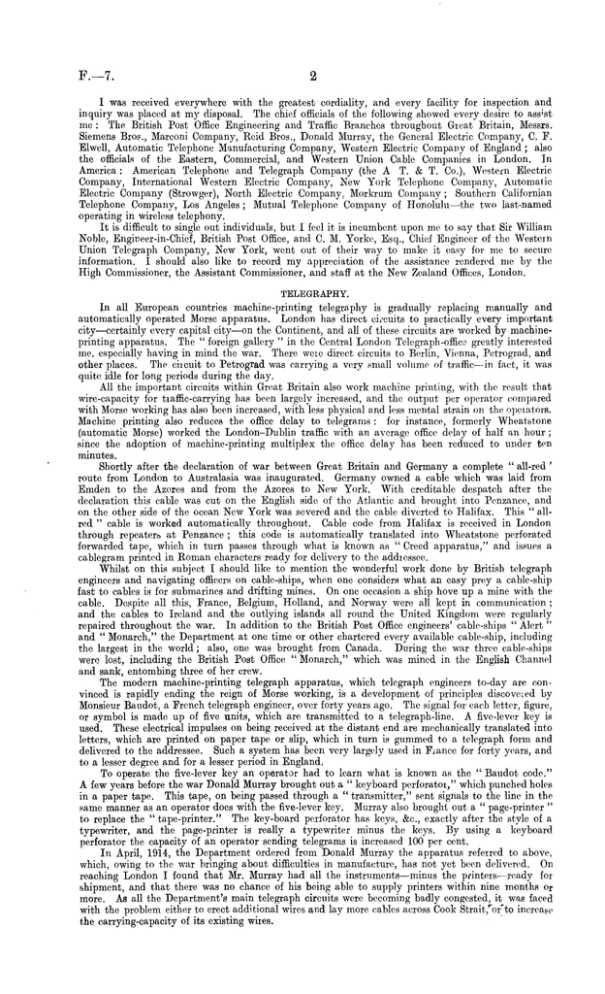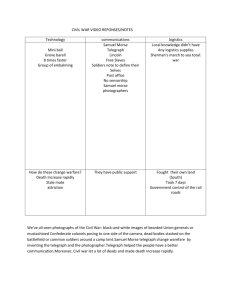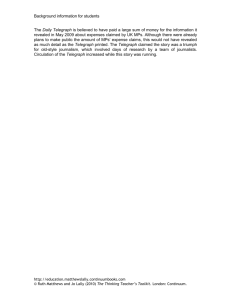Appendix to the Journals of the House of
advertisement

F.—7 2 I was received everywhere with the greatest cordiality, and every facility for inspection and inquiry was placed at my disposal. The chief officials of the following showed every desire to assist me : The British Post Office Engineering and Traffic Branches throughout Great Britain, Messrs. Siemens Bros., Marconi Company, Rcid Bros., Donald Murray, the General Electric Company, C. F. Elwell, Automatic Telephone Manufacturing Company, Western Electric Company of England ; also the officials of the Eastern, Commercial, and Western Union Cable Companies in London. In America : American Telephone and Telegraph Company (the A T. & T. Co.), Western Electric Company, International Western Electric Company, New York Telephone Company, Automalic Electric Company (Strowger), North Electric Company, Morkrum Company ; Southern Californian Telephone Company, Los Angeles ; Mutual Telephone Company of Honolulu—the two last-named operating in wireless telephony. It is difficult to single out individuals, but I feel it is incumbent upon me to say that Sir William Noble, Engineer-in-Chief, British Post Office, and C. M. Yorke, Esq., Chief Engineer of the Western Union Telegraph Company, New York, went out of their way to make it easy for me to secure information. I should also like to record my appreciation of the assistance rendered, me by the High Commissioner, the Assistant Commissioner, and staff at the New Zealand Offices, London. TELEGRAPHY. In all European countries machine-printing telegraphy is gradually replacing manually and automatically operated Morse apparatus. London has direct circuits to practically every important city—certainly every capital city—on the Continent, and all of these circuits are worked by machineprinting apparatus. The " foreign gallery "in the Central London Telegraph-office greatly interested me. especially having in mind the war. There weie direct circuits to Berlin, Vienna, Petrograd, and other places. The circuit to Petrograd was carrying a very small volume of traffic—in fact, it was quite idle for long periods during the day. All the important circuits within Great Britain also work machine printing, with the result that wire-capacity for traffic-carrying has been largely increased, and the output per operator compared with Morse working has also been increased, with less physical and less mental strain on the operators. Machine printing also reduces the office delay to telegrams : for instance, formerly Wheatstone (automatic Morse) worked the London-Dublin traffic with an average office delay of half an hour ; since the adoption of machine-printing multiplex the office delay has been reduced, to under ten minutes. Shortly after the declaration of war between Great Britain and Germany a complete " all-red ' route from London to Australasia was inaugurated. Germany owned a cable which was laid from Emden to the Azores and from the Azores to New York. With creditable despatch after the declaration this cable was cut on the English side of the Atlantic and brought into Penzance, and on the other side of the ocean New York was severed and the cable diverted to Halifax. This " allred " cable is worked automatically throughout. Cable code from Halifax is received in London through repeaterb at Penzance ; this code is automatically translated into Wheatstone perforated forwarded tape, which in turn passes through what is known as " Creed apparatus," and issues a cablegram printed in Roman characters ready for delivery to the addressee. Whilst on this subject I should like to mention the wonderful work done by British telegraph engineers and navigating officers on cable-ships, when one considers what an easy prey a cable-ship fast to cables is for submarines and drifting mines. On one occasion a ship hove up a mine with the cable. Despite all this, France, Belgium, Holland, and Norway were all kept in communication ; and the cables to Ireland and the outlying islands all round the United Kingdom were regularly repaired throughout the war. In addition to the British Post Office engineers' cable-ships " Alert " and " Monarch," the Department at one time or other chartered every available cable-ship, including the largest in the world ; also, one was brought from Canada. During the war three cable-ships were lost, including the British Post Office " Monarch," which was mined in the English Channel and sank, entombing three of her crew. The modern machine-printing telegraph apparatus, which telegraph engineers to-day are convinced is rapidly ending the reign of Morse working, is a development of principles discovered by Monsieur Baudot, a French telegraph engineer, over forty years ago. The signal for each letter, figure, or symbol is made up of five units, which are transmitted to a telegraph-line. A five-lever key is used. These electrical impulses on being received at the distant end are mechanically translated into letters, which are printed on paper tape or slip, which in turn is gummed to a telegraph form and delivered to the addressee. Such a system has been very largely used in Fiance for forty years, and to a lesser degree and for a lesser period in England. To operate the five-lever key an operator had to learn what is known as the " Baudot code." A few years before the war Donald Murray brought out a " keyboard perforator," which punched holes in a paper tape. This tape, on being passed through a " transmitter," sent signals to the line in the same manner as an operator does with the five-lever key. Murray also brought out a " page-printer " to replace the " tape-printer." The key-board perforator has keys, &c, exactly after the style of a typewriter, and the page-printer is really a typewriter minus the keys. By using a keyboard perforator the capacity of an operator sending telegrams is increased 100 per cent. In April, 1914, the Department ordered from Donald Murray the apparatus referred to above, which, owing to the war bringing about difficulties in manufacture, has not yet been delivered. On reaching London I found that Mr. Murray had all the instruments—minus the printers—ready for shipment, and that there was no chance of his being able to supply printers within nine months or more. As all the Department's main telegraph circuits were becoming badly congested, it was faced with the problem either to erect additional wires and lay more cables across Cook Strait,ror'to increase the carrying-capacity of its existing wires.



